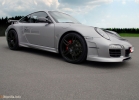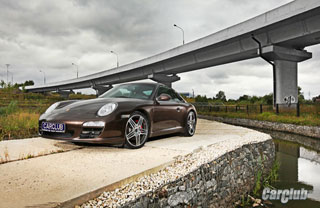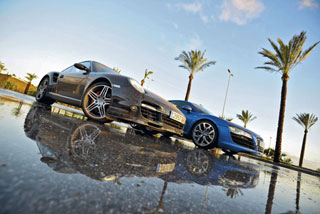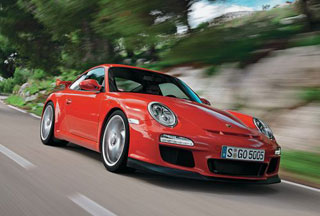Test drive Porsche 911 Carrera 997 since 2008 coupe
Crazes twice
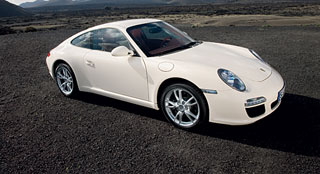 By its 60th anniversary, Porsche introduced the new Carrera. Light plastic has once again damaged recognition, and the main changes still occur under the skin. In a good way, a stubborn family business carefully retains the nature of the machine that brought popularity to the whole brand. Although here you have a fresh trend for environmentally responsible ones: the release of adrenaline is inversely proportional to the harmful emissions of the engine.
By its 60th anniversary, Porsche introduced the new Carrera. Light plastic has once again damaged recognition, and the main changes still occur under the skin. In a good way, a stubborn family business carefully retains the nature of the machine that brought popularity to the whole brand. Although here you have a fresh trend for environmentally responsible ones: the release of adrenaline is inversely proportional to the harmful emissions of the engine. Even for a pan-European test drive, Porsche did not want to let go of the first batch of fresh 911 far from her native Weissaha. Here, in the immediate vicinity of the plant and the development center, everyone knows about the car.
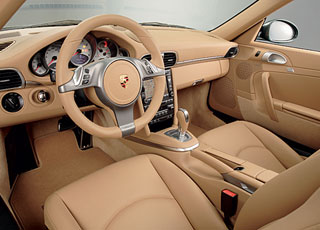 For example, as the viciously roaring six -cylinder Opposite engines Boxer, developing 345 and 380 hp are combined with the ecology. Now these engines with a volume of 3.6 and 3.8 liters, adding 20 and 30 hp. Accordingly, they eat gasoline in the range from 9.8 to 10.8 liters per hundred, depending on the body and gearbox option.
For example, as the viciously roaring six -cylinder Opposite engines Boxer, developing 345 and 380 hp are combined with the ecology. Now these engines with a volume of 3.6 and 3.8 liters, adding 20 and 30 hp. Accordingly, they eat gasoline in the range from 9.8 to 10.8 liters per hundred, depending on the body and gearbox option. Many manufacturers, announcing in advance of compliance with the Euro-5 standards that have not yet entered into force, deliberately strangled their engines. They could not go to Porsche, so they began to improve the engine without loss of power and dynamics. The result was the increase in horses and a decrease in harmful emissions.
Porshevsky engine is just some kind of hymn in effectiveness. To begin with, a more successful layout made it possible to reduce the height of the engine and, accordingly, the center of gravity of the entire machine - here is an improvement in controllability. If we talk about technology and constructive changes, then in the new engine 40% less details, and their strength, thanks to new alloys, is increased by 22%. In the new generation, they chased not only in cubic centimeters and horses. For example, a new oil circulation system was introduced. It should be borne in mind that the car provides for operation in the mode of significant
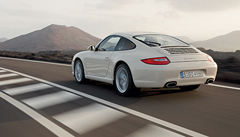 lateral accelerations, and the new system is called in the literal sense to prevent it from drying out. The problem cannot be solved by excess supply - the oil is served in strictly necessary quantities, for which the pump with electronic control and special software is used. For tests, the motor was driven on wandering stands that simulate an active ride. As a result, the oil supply system itself saves as many as 3 hp. and reduces fuel consumption by 2%. In addition, in the new generation of 911, a direct fuel injection was first used, and the weight of the power unit, despite the increase in power, decreased by 5 kg.
lateral accelerations, and the new system is called in the literal sense to prevent it from drying out. The problem cannot be solved by excess supply - the oil is served in strictly necessary quantities, for which the pump with electronic control and special software is used. For tests, the motor was driven on wandering stands that simulate an active ride. As a result, the oil supply system itself saves as many as 3 hp. and reduces fuel consumption by 2%. In addition, in the new generation of 911, a direct fuel injection was first used, and the weight of the power unit, despite the increase in power, decreased by 5 kg. 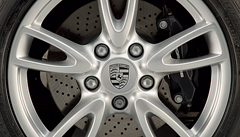 Two body options are two traditional Coupe and Cabrio, and in addition to a six -speed manual box, for the first time in the Porsche serial story, a piece with a long name Porsche Doppelkuplungsgetriebe (PDK) is supplied. In fact, it has become a double clutch transmission that has already become familiar among other manufacturers, although the primacy of its application is still for Porsche. The company worked a similar principle of gear shift in the 80s on the 962 sports model for the group C.
Two body options are two traditional Coupe and Cabrio, and in addition to a six -speed manual box, for the first time in the Porsche serial story, a piece with a long name Porsche Doppelkuplungsgetriebe (PDK) is supplied. In fact, it has become a double clutch transmission that has already become familiar among other manufacturers, although the primacy of its application is still for Porsche. The company worked a similar principle of gear shift in the 80s on the 962 sports model for the group C. 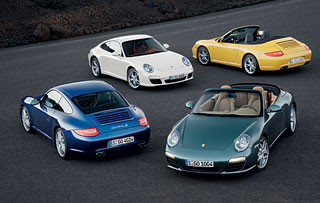 From now on, the Tiptronic S transmission will not be put on Carrera. The new box is more tightened (the weight is reduced by as much as 10 kg), but the harmony in this case is a decisive criterion. PDK is also twice as fast. Porsche experts do not directly talk about this, but, apparently, there is a change in transmission generations. The new system has to test itself in the classics, after which it can also appear on other representatives of the model range after their planned update.
From now on, the Tiptronic S transmission will not be put on Carrera. The new box is more tightened (the weight is reduced by as much as 10 kg), but the harmony in this case is a decisive criterion. PDK is also twice as fast. Porsche experts do not directly talk about this, but, apparently, there is a change in transmission generations. The new system has to test itself in the classics, after which it can also appear on other representatives of the model range after their planned update. It is recommended to feed the car with gasoline with an octane number 98, although the developers assure that the new Carrera also digest 86, which, however, will not affect the characteristics of the engine, both in an instant and long -term perspective.
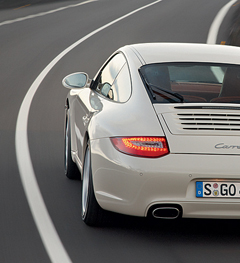 If the machine has an optional Sport Chrono Plus package, in the lower part of the middle console you can see three modest buttons that provide the notorious Fun to Drive. The normal regime restrains the temperament of the engine and suspension - maximum efficiency and smoothness plus swallowing small irregularities of the road. The automatic gearbox tries to reach the upper steps as soon as possible - there is enough traction at low speeds, but the consumption drops noticeably. Sport mode translates the engine into a state of increased sensitivity, and pressing the accelerator pedal shoots the car forward. Sport Plus uses the Launch Control racing start system and allows you to use a stopwatch integrated into the dashboard. The system allows you to consider the circle time, which is unequivocally hinting: you should drive on a prepared highway, and not in the city. However, overtaking a tractor with sharp rebuilding to the left also gives considerable pleasure.
If the machine has an optional Sport Chrono Plus package, in the lower part of the middle console you can see three modest buttons that provide the notorious Fun to Drive. The normal regime restrains the temperament of the engine and suspension - maximum efficiency and smoothness plus swallowing small irregularities of the road. The automatic gearbox tries to reach the upper steps as soon as possible - there is enough traction at low speeds, but the consumption drops noticeably. Sport mode translates the engine into a state of increased sensitivity, and pressing the accelerator pedal shoots the car forward. Sport Plus uses the Launch Control racing start system and allows you to use a stopwatch integrated into the dashboard. The system allows you to consider the circle time, which is unequivocally hinting: you should drive on a prepared highway, and not in the city. However, overtaking a tractor with sharp rebuilding to the left also gives considerable pleasure. 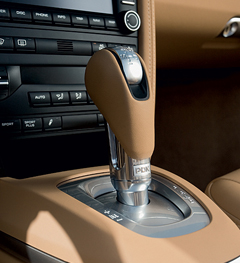 To match the expectations of the new generation of customers, the car expanded the multimedia display and added sensory control. The headlights have acquired LEDs, and an adaptive lighting system in corners can be ordered as an option (the changed optics mainly allows you to distinguish a new generation). But in general, 911 remained itself, and this is almost the only machine in which constancy pleases. He still lays his ears from the sound of the engine, but not a single client asked for silence. Clients ask for Porsche 911 only drive. And they pay for this for 45 years in a row.
To match the expectations of the new generation of customers, the car expanded the multimedia display and added sensory control. The headlights have acquired LEDs, and an adaptive lighting system in corners can be ordered as an option (the changed optics mainly allows you to distinguish a new generation). But in general, 911 remained itself, and this is almost the only machine in which constancy pleases. He still lays his ears from the sound of the engine, but not a single client asked for silence. Clients ask for Porsche 911 only drive. And they pay for this for 45 years in a row. Abstracts after
1. In the new generation, they chased not only in cubic centimeters and horses. Somehow, a roaring opposition motor is combined with the latest environmental standards.
2. The new PDK gearbox is twice faster, weighs 10 kg less and saves fuel.
3. From the sound of the engine, he still lays his ears, but not a single client asked for silence.
Porsche Carrera S 911 Coupe
Boxer-6 engine
Raboche volume (cubic cub) 3800
Power (L.S. at about/min) 385 at 6500
Moment (nm at rpm) 420 at 4400
The rear drive
Automatic gearbox 7-st. PDK
Length/width/height (mm) 4435/1808/1310
Equipped mass (kg) 1425
Maximum speed (km/h) 250
Acceleration to 100 km/h (c) 4.5
Fuel consumption, city
Cycle (l/100 km) 15.9 prices in Moscow (rub.) 4 393,000
Source: "Autopilot"





